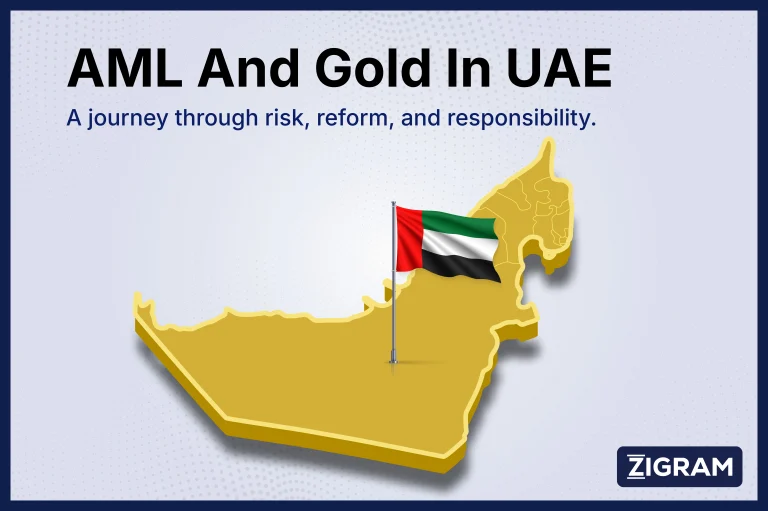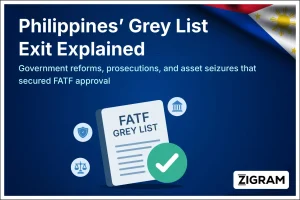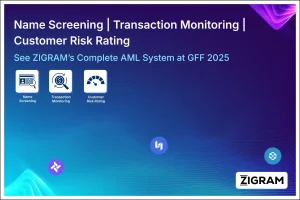The United Arab Emirates (UAE) is a major global hub for gold and precious metals trading. This sector’s intrinsic characteristics – high value, portability and liquidity – make it high-risk for money laundering (ML) and terrorist financing (TF). Combating illicit gold flows has become a top priority for UAE regulators, especially following the UAE’s 2021 greylisting by the FATF. This report examines the UAE’s AML/CFT framework for gold and precious metals from 2021 to 2025, including enforcement trends and typologies, regulatory oversight, FATF alignment (with a focus on the impact of greylisting), and practical compliance guidance for DNFBPs (Dealers in Precious Metals and Stones – DPMS).

High-Risk Nature of Gold and Precious Metals
Precious metals and stones are inherently attractive to criminals due to their high intrinsic value in compact form and relative anonymity. Unlike most goods, gold and gems retain or increase value and can be easily transported and hidden. For example, official guidance notes that “PMS represent high intrinsic value in a relatively compact form” and “can be easily transported physically in many forms”. Criminals use gold both to generate illicit proceeds (e.g. via fraud or drug sales) and to launder those proceeds. Gold can circulate as a form of currency or be traded informally across borders, offering anonymity. Moreover, gold and diamonds often trade in large, decentralized cash markets worldwide, enabling criminals to convert cash into gold (and back) with minimal recordkeeping. In short, gold’s combination of value, demand and cross-border liquidity creates a powerful money-laundering opportunity.
The UAE’s own National Risk Assessments (NRA) and FIU analyses recognize this. A 2022 UAEFIU typology report emphasizes that “precious metals and stones (PMS) are attractive to criminals and terrorists because they offer a high level of liquidity and anonymity, in addition to their compact size so that they can easily be stored or smuggled”. The UAE categorizes dealers in precious metals and stones (DPMS) as a DNFBP sector with high inherent ML/TF vulnerability. Indeed, the UAE NMRA describes the onshore DPMS sector as having “one of the highest inherent ML/TF vulnerabilities”. In practice, criminals have repeatedly targeted this sector. For example, a notorious 2021 Abu Dhabi case involved a Ponzi-style gold investment fraud: four expatriates and a jewelry trader defrauded around 4,000 investors by offering fake gold trading schemes, ultimately seizing over 7 kg of 18-carat gold in the bust. That case underlines how fraudsters exploit gold’s allure to perpetrate scams and layer funds.
Typical money-laundering schemes in gold include trade-based laundering (over- or under-invoicing gold exports/imports), illicit import of conflict or black-market gold from high-risk regions, cash smuggling into the UAE to buy gold, and rapid resale or outflows after purchase. Gold can also be used as an exchange mechanism in opaque cross-border deals. For example, the UAEFIU has highlighted DPMS entities using gold “as a medium of exchange” and conducting “unnecessarily layered” transactions to obscure origins. Trade invoices for gold may be falsified or incomplete, and gold imports from unlikely origin countries (with no known mines) are red flags. In sum, the high-risk indicators in this sector often revolve around large cash flows, unusual trade flows, and opaque business structures (see below).
AML/CFT Regulatory Framework (2021–2025)
Since 2018 the UAE has built a comprehensive AML/CFT legal framework, with significant upgrades during 2021–2025. The cornerstone law is Federal Decree-Law No. 20 of 2018 (AML/CFT Law), with its Executive Regulation (Cabinet Decision 10/2019). These establish universal obligations: customer due diligence (CDD), recordkeeping, internal controls, and mandatory reporting of suspicious transactions. Crucially, Cabinet Decision 10/2019 expressly designates DPMS as a DNFBP sector. Any DPMS must perform CDD on clients and report any cash or wire transaction (single or linked) ≥ AED 55,000 (≈USD 15,000) to the UAE Financial Intelligence Unit (UAEFIU). The same obligations apply to diamond traders and jewelry businesses (as they fall under PMS definitions).
2021–2022 Updates: In response to international scrutiny, the UAE enacted several reforms. Federal Decree-Law No. 26 of 2021 amended Law 20/2018 to strengthen oversight. Among other changes, it formalized the National Committee to Combat ML/CFT and expanded coverage to virtual asset service providers (VASPs). That period also saw implementation measures: for example, the Ministry of Economy Circular 2/2021 extended the goAML registration deadline for all DNFBPs (including gold dealers) to April 30, 2021, reflecting the push to bring every jeweler and refiner into the STR reporting system. By late 2021, all DPMS firms were expected to have registered on goAML for STR filing.
In August 2022, the Ministry of Economy issued its “Due Diligence Regulations for Responsible Sourcing of Gold.” This set mandatory requirements for gold refiners to implement a rigorous supply-chain due diligence process. Following OECD guidance on conflict minerals, it requires refiners to: establish a strong management system; identify and assess gold supply-chain risks; devise a strategy to address those risks; engage in independent third-party reviews of their sourcing practices; and report findings periodically. The idea is to complement CDD – by ensuring refiners trace gold from mine/region to market – thereby preventing conflict or illicit gold from entering the UAE system. In practice, refiners must collect documentation on each supplier (ore/mine of origin, mining methods, ownership, etc.), and trigger enhanced due diligence on any suspicious upstream supplier or country. Notably, the regulations identify high-risk origins (e.g. Countries of Artisanal and Small-scale Mining – CAHRAs, nations with conflict gold flows, etc.) as red flags. From 2023 onwards refiners are audited on these measures, with a required independent review each year.
2023–2024 Reforms: In 2024 the UAE continued to bolster AML oversight. Federal Decree-Law No. 7 of 2024 (the “New AML Law”) amended Law 20/2018 and came into force in August 2024. Its centerpiece was new governance: it created a National Committee for Combating ML/TF (with a General Secretariat) to coordinate policy, replacing the earlier Executive Office. It also restructured the existing Higher Committee into a Supreme Committee responsible for supervising the national AML/CFT strategy. Both committees report at the highest levels (Presidential Court/Cabinet), signaling top priority. The New AML Law additionally tasked the National Committee with identifying high-risk countries/jurisdictions and coordinating countermeasures, as well as strengthening information exchange among regulators (domestic and international).
Meanwhile, the Ministry of Economy has sharpened enforcement tools. For example, Ministerial Decree 68/2024 (Oct. 2024) formally requires all UAE gold refiners to comply with the above sourcing regulations. Other measures include new penalties: Cabinet Resolution 71/2024 (Oct. 2024) set fines for AML violations under MoE/Ministry of Justice control, and Cabinet Decisions 132/2023 and 109/2023 (late 2023) impose administrative fines on violators and update beneficial ownership rules. Registrars are now obliged to identify corporate beneficial owners (natural persons holding ≥25% of shares or voting rights) in line with FATF standards.
In sum, by 2025 the UAE’s AML/CFT law covers DNFBPs comprehensively, with heavy reporting duties on gold dealers and refiners. DNFBP guidelines (CDD guides, risk-based manuals) have been updated to reflect these reforms. The Ministry of Economy regularly issues sector-specific guidance: for example, it publishes “Supplemental Guidance for Dealers in Precious Metals and Stones”, which echoes FATF/IMF advice on this sector (e.g. explaining why gold is vulnerable and listing typologies). This layered framework – laws, regs, ministerial rules and circulars – underscores that UAE authorities view the gold sector as requiring strict AML controls.
Enforcement Actions and Typologies (2021–2025)
Authorities have pursued both criminal cases and regulatory sanctions in the gold sector. Notable cases and actions include:
Jewelry investment fraud (2021):
An Abu Dhabi court in March 2021 convicted four expatriates and a jeweler in a fraud/Money Laundering scheme. The defendants ran a fake “gold investment” Ponzi scheme, duping ~4,000 people into handing over funds. The court ordered fines totaling AED 90 million (plus prison and deportation) and seized ~7.4 kg of 18-carat gold worth AED 1.37 million. This case highlighted how criminals exploit the allure of gold – promising high returns – to launder criminal proceeds.
DNFBP fines (2022–2023):
Regulators have imposed heavy penalties on AML violations by dealers. In November 2022, the Ministry of Economy fined three companies a total of AED 2.25 million for 32 AML/CFT breaches; two of the firms were in the gold-and-gemstones trade. In March 2023, MoE announced fines of AED 22.6 million on 29 DNFBP companies for AML non-compliance. Among those 29 were 17 firms in the precious metals and gems sector, which were cited for failing to adopt risk-based controls, screen customers or transactions against terror lists, and establish internal AML policies. MoE emphasized that such enforcement was needed to “ensure the country’s full compliance with the international standards issued by the Financial Action Task Force”.
Gold refinery suspensions (2024):
In a major crackdown, the UAE in August 2024 temporarily suspended 32 local gold refinery licenses (about 5% of Dubai’s refineries) for AML/CFT breaches. Inspections by the Ministry of Economy found 256 separate violations among these refineries, including inadequate customer due diligence, failure to file Suspicious Transaction Reports, and not screening clients against terrorism watchlists. The suspensions (July–Oct 2024) sent a clear signal: compliance lapses in the gold trade would be met with strict sanctions.
These enforcement actions reflect emerging typologies and red flags:
Cash-intensive, round-tripping patterns:
DPMS businesses often handle large cash flows. Typical red flags include large cash deposits followed by immediate withdrawals or transfers abroad, and transactions split into several payments to evade reporting thresholds. For example, analysts note scenarios like “deposits or transfers in a DPMS account followed by the immediate transfer of similar amounts to another jurisdiction”. Likewise, frequent use of foreign currency exchange without business rationale is suspicious.
Complex corporate structures:
Money launderers may hide behind opaque ownership. Authorities flag DPMS entities with “unreasonable and complex” corporate arrangements (shell companies, offshore parents) designed to conceal ultimate beneficial owners. Other red flags are multiple bank accounts for one dealer (or under employee names) and extensive layering of transactions to obscure fund origins.
Unusual trade flows/origins:
Importing precious metals from improbable sources raises suspicion. For instance, a dealer importing large quantities of gold from a country with no gold mines would be highly unusual. The official due-diligence guidelines similarly warn that gold originating from or transiting CAHRAs (conflict-affected mining regions) or sanctioned countries is a red flag. In practice, traders should be wary of suppliers who cannot verify origin (e.g. recycled/scrap gold from transit hubs).
Weak supplier controls:
Guidance notes that counterparties who lack AML/ethical safeguards are suspicious. Examples include gold suppliers that refuse to provide business documents, give inconsistent KYC information, or appear on international sanctions/terrorism lists. Dealing with such suppliers without enhanced due diligence is a compliance failure.
Trade documentation issues:
Invoicing or shipping papers with vague or counterfeited details are a common red flag. Physical gold trades may be accompanied by invoices that are “counterfeit” or frequently modified. If trade routes or contract terms deviate from normal practices (e.g. illogical routing, phantom intermediaries), investigators consider the transaction suspicious.
In short, alert indicators in the precious-metals sector include: very large cash payments; splitting high-value purchases into smaller payments; customers who resist KYC (e.g. tourists with flimsy IDs); and deals involving high-risk jurisdictions. The UAEFIU’s published risk indicators for DPMS combine many of the above: for instance, it explicitly warns of front companies mixing legitimate and illicit gold dealings, using gold to move funds between multiple accounts, and deals with no clear commercial rationale. Recognizing these red flags helps compliance officers spot laundering attempts early.
Role of Regulatory Bodies
The UAE’s AML/CFT regime involves multiple authorities:
UAE Financial Intelligence Unit (UAEFIU): Operated under the Central Bank, the UAEFIU is the national AML/CFT watchdog. It runs the goAML system for STR collection and “analyses suspicious transactions and activities … from financial institutions (FIs) and DNFBPs”. In 2022 the FIU reported a 121% increase in STR submissions by DNFBPs compared to 2021, reflecting heightened reporting activity (especially from gold dealers). The FIU processes reports, conducts strategic analysis (e.g. issuing typology reports on DPMS risks) and disseminates intelligence to law enforcement. It reported disseminating 123 proactive intelligence notes in 2022 and executing freeze orders in 9 cases (totaling ~AED 452 million frozen). The FIU also circulates guidance (red-flag videos, case studies) to help DNFBPs meet their obligations. Compliance officers should maintain an active relationship with the FIU—for example, ensuring timely STR filing via goAML and reviewing any FIU feedback.
Central Bank of the UAE (CBUAE):
As the supervisor of banks and financial institutions, CBUAE enforces AML rules for the financial sector and monitors any bank service providers to DPMS entities. CBUAE publishes AML/CFT rules and best-practice circulars (e.g. in its Rulebook) and shares risk warnings with banks to watch for suspicious activity tied to gold or cash transactions. CBUAE also oversees the AML framework nationally, supporting the FIU and coordinating with other supervisors.
Ministry of Economy (MoE):
The MoE is the designated supervisor for DNFBPs, including precious-metals firms, throughout the UAE (onshore and free zones). It issues sector-specific guidelines (e.g. DNFBP CDD guides), conducts inspections, and imposes penalties for non-compliance. The MoE spearheads enforcement in the gold sector, as evidenced by its high-profile fines and refinery suspensions. It also publishes circulars (e.g. lists of high-risk countries) and runs outreach programs (trainings, “Al Manara” newsletters) to educate DNFBPs. Compliance officers should monitor MoE pronouncements closely: for instance, MoE’s AML portal and bulletins (including mandatory goAML registration notices) provide updated regulations and timelines.
Other bodies:
The UAE’s National Anti-Money Laundering and Terrorism Financing Committee (NAMLTC), chaired by UAE Central Bank, coordinates AML/CFT policy at a high level. In 2024, the Supreme Committee (under Presidential Court oversight) will additionally supervise the new AML Strategy. Entities like the Dubai Multi Commodities Centre (DMCC) also enforce AML rules in their jurisdictions for companies registered there. Law enforcement agencies (police, prosecutors) investigate and prosecute ML/TF crimes, working closely with the FIU.
Overall, inter-agency cooperation is strong. The AML Law mandates collaboration among the FIU, CBUAE, MoE and others. For compliance officers, the takeaway is: report STRs to the FIU promptly; respond to MoE or CBUAE audit requests; and ensure systems can quickly implement any new regulator guidance (e.g. updates to beneficial ownership registers or sanctions lists).
UAE Alignment with FATF Standards and the Greylist
UAE authorities explicitly aim to align with FATF Recommendations. The AML Law and regulations cover all 40+9 FATF areas – from CDD and STR reporting to terrorism financing and proliferation financing. The country underwent a joint FATF-MENAFATF mutual evaluation in late 2019, and in 2021 it was placed on FATF’s “grey list” (the Increased Monitoring list) due to identified deficiencies (notably in supervision of DNFBPs and in criminal justice). The greylisting prompted a national push for reform.
From 2021 through 2023, the UAE made several improvements: enhancing legal powers (see above), strengthening DNFBP supervision, and increasing resourcing for enforcement. For example, FATF’s February 2022 follow-up report on UAE noted “significant reforms” in AML laws and institutions. The UAE also published its National Risk Assessment and AML Strategy, and formally acknowledged gold (and virtual assets) as priority risk areas. These efforts paid off: at the FATF plenary on 23 February 2024, FATF announced that the UAE was no longer subject to increased monitoring. In the joint press release, FATF singled out the UAE’s enactment of “key reforms” in law and its increased enforcement actions as the basis for delisting. (The earlier quoted sources note February 2024 removal.)
Even after delisting, FATF expects ongoing effectiveness. The 2024–2027 AML Strategy (launched September 2024) explicitly aims to fully meet FATF standards in practice. UAE authorities have committed to continuous risk-based supervision of all sectors (including gold), and enhanced international cooperation (sharing STRs and FIU data with counterparts). For compliance officers, this means that FATF-style vigilance must continue: remaining compliant with evolving rules is essential for the UAE to maintain its standing.
Risk Indicators and Red Flags for Precious-Metals Dealers
Compliance officers in the DPMS sector should be alert to specific risk indicators, including:
Geographical risk:
Gold transactions involving high-risk countries (known conflict zones, subject to sanctions, or with weak AML controls) are suspect. For instance, gold claimed from or routed through CAHRAs (conflict-affected mining areas) or sanctioned states should trigger enhanced scrutiny. Likewise, importing gold from a nation without any gold production is unusual.
Supplier red flags:
A supplier who is new or unknown to the market, refuses to provide documentation, or gives inconsistent information is a concern. Other red flags include suppliers tied to entities in high-risk locations, or those with politically exposed persons (PEPs) as owners.
Payment patterns:
Recurrent large cash payments (especially just below the AED 55,000 threshold) are a classic red flag. Payments split across multiple instruments (cash, money orders, third-party accounts) to obscure funding sources are suspicious. Rapid back-to-back transactions – e.g. incoming funds immediately wired out – may indicate layering.
Unusual transaction structure:
Dealings involving multiple related accounts, complex corporate layers, or accounts opened in employees’ names can signal concealment. The FIU warns that DPMSs acting as front companies (mixing legitimate and illegitimate cash dealings) are a risk factor.
Trade documentation:
Contracts, invoices or shipping documents for precious metals that are vague, frequently altered, or counterfeit should raise alarm. Overvaluing or undervaluing the goods on invoices relative to market value is also suspect.
Customer profile:
Purchases by tourists or one-time buyers (especially of high-value gold without clear need) merit caution. Frequent purchases by customers with minimal KYC (like spot cash buyers or third-party beneficiaries) are risky. Transactions involving persons on watchlists or designated by sanctions are immediate red flags.
Gold as currency:
Any use of gold purely as a means of payment or transfer of value (rather than a legitimate sale) is suspicious. For example, if a dealer accepts gold from a client in lieu of payment and then resells it on the same day, this could indicate attempt to hide cash movement.
Integrating these red flags into transaction monitoring systems and staff training is key. Many of the above indicators are documented in UAE guidance materials (e.g. UAEFIU’s DPMS risk report and MoE supplemental guidelines), so compliance teams should review those periodically.
Compliance Challenges for DNFBPs in Precious Metals
Compliance officers face sector-specific difficulties:
Cash-based, high-value trades:
Precious-metals dealers often handle large cash volumes. As noted by industry commentators, it’s common to split big payments (e.g. half in cash, half in a bank transfer, or via money orders) to conceal the true amount. This complicates KYC: tracking multiple partial payments is a heavy manual task, and informal cash deals (common in some UAE markets) can bypass formal banking records.
Tourist clientele:
Dubai attracts shoppers from around the world. Dealers report that a large share of customers are tourists with limited local presence. This transient profile makes ongoing monitoring and CDD difficult. Obtaining reliable identification or source-of-funds proof from a foreign tourist is often challenging, raising compliance strain.
Cross-border nature:
The gold business by definition is international. Dealers routinely import and export to many jurisdictions, each with its own rules. This exposes them to different compliance regimes and creates confusion (e.g. a payment structure legal in one country may violate UAE AML requirements). Diverse documentation standards and logistics (securing customs forms for gold shipments) add operational complexity.
Opaque supply chains:
The upstream mining and trading of gold is complex and fragmented. A gold bar may pass through multiple refiners, traders and collectors before reaching a UAE dealer. Tracking the provenance through all these intermediaries is often beyond a single dealer’s visibility. Ensuring that each link in the chain has valid export licenses and AML controls is a major challenge.
Knowledge gap and culture:
Many small jewelers and traders are family-owned businesses with limited AML expertise. Compliance culture is relatively new in this sector, and lack of training can lead to gaps (e.g. failing to cross-check names against watchlists). Ensuring all front-line staff (salespersons, treasurers) understand their legal obligations is an ongoing task.
These factors mean DNFBPs must work harder than banks to maintain robust AML programs. Many struggle with resource constraints (few have in-house compliance officers) and must adapt systems originally designed for financial institutions. Coordinating across free zones (where some regulation differs) is also a headache. Regulators have tried to help – for example, the MoE publishes easy-to-use red-flag checklists and offers training seminars – but the sheer heterogeneity of the sector means compliance standards can vary widely from one trader to another.
Best Practices and Recommendations
Given the risks above, compliance officers should adopt a risk-based, structured AML program tailored to precious metals. Key recommendations include:
Thorough Customer Due Diligence (CDD):
Know your customer and beneficial owners. Verify identity documents and require proof of source of funds for large gold purchases. For all transactions ≥AED 55,000, file a Dealer in Precious Metals and Stones Report (DPMSR) to the FIU. Even below that threshold, apply enhanced due diligence to high-risk customers (e.g. foreign buyers, PEPs, or cash-intensive accounts). Be especially wary of proxies or third parties paying on a customer’s behalf without clear explanation.
Supply-Chain Due Diligence:
Follow the OECD-aligned five-step framework mandated by UAE regulations. Implement a strong internal control system (Step 1) that includes policies for tracking origin of gold. Conduct periodic enterprise-wide risk assessments to identify high-risk suppliers or geographies (Step 2). Develop a risk-mitigation strategy (Step 3) – for example, refraining from gold purchases from a high-risk mine unless additional proof is given. Arrange independent third-party audits of your sourcing process (Step 4) – for UAE refiners this is now required annually. And submit regular internal reports (Step 5) to management documenting these due-diligence efforts.
Robust AML/CFT Policies:
Formalize written AML policies and procedures specific to gold trading. Cover all CDD stages, record retention, transaction monitoring and suspicious-reporting protocols. Include guidelines on the red flags identified above. Given the sector’s complexity, tailor the program to your firm’s size and risk profile (risk-based approach). For example, if you deal in large bars, set additional limits or checks for each bar purchase.
Transaction Monitoring:
Even without banking surveillance, dealers should monitor for unusual patterns. Keep computerized logs of all sales (amounts, payment method, customer). Watch for structuring (transactions just below AED 55,000), repeated sales followed by immediate transfers, or clusters of high-value purchases by a single customer. Many compliance software vendors offer AML tools adaptable to precious-metals businesses.
Staff Training:
Regularly train employees on AML/CFT obligations and sector-specific risks. Employees must recognize fraudulent schemes (e.g. gold investment scams) and know how to react to suspicious requests (e.g. a customer insisting on bypassing normal procedures). Drills and case studies (including examples of typologies) can reinforce vigilance.
Sanctions and PEP Screening:
Integrate name-screening against UAE and UN/Terror lists into the CDD process. Any match (direct or fuzzy) should be escalated immediately. Also screen customers against designated PEPs, especially those from corruption-prone countries. While there is no explicit PEP “exclusion” rule for DNFBPs in UAE law, enhanced scrutiny of politically exposed clients is prudent best practice.
Record-Keeping:
Maintain transaction records, customer ID copies and due-diligence materials for at least five years (longer if required by law or case specifics). Store them securely and ensure they are readily accessible for regulator audits or FIU requests. This includes receipts/invoices for gold trades, even small ones, as part of the audit trail.
Independent Audit:
Arrange periodic independent reviews or audits of your AML program. This could be internal audit staff or external consultants. Audits can identify control gaps (e.g. outdated watchlists, weak procedures) before regulators do.
Engagement with Authorities:
Actively cooperate with the FIU and regulators. Register on goAML and promptly report all suspicious transactions. Respond quickly to any MoE or CBUAE inquiries or inspections. Consider participating in industry forums (e.g. workshops by MoE/DMCC) and subscribing to FATF/World Bank updates relevant to gold trading.
Technology and Process:
Where possible, use automated compliance tools. Digital customer onboarding (scanning passports, verifying against lists), transaction-screening software, and centralized databases can reduce manual error. Standardize the onboarding checklist to flag incomplete paperwork (no source-of-funds declaration, etc.) at the start of a relationship.
By adopting these measures, DPMS firms can significantly mitigate ML/TF risks. In particular, supply-chain transparency – once an emerging concept – has become mandatory in the UAE; compliance officers must ensure their firms can document the journey of every bar of gold. Compliance units should also stay abreast of evolving global best practices (e.g. Responsible Jewellery Council’s Chain-of-Custody standards, OECD guidance on minerals) and incorporate them where applicable.
Conclusion
From 2021 onward, the UAE has dramatically upgraded its AML/CFT controls, with a special focus on gold and precious metals trading. The combination of enhanced legal obligations (laws, decrees, due-diligence regs) and vigorous enforcement (fines, license suspensions) reflects the authorities’ recognition that this sector poses outsized ML/TF risks. For compliance officers in the gold trade, the message is clear: treat your operations with the same rigor as a bank. Apply a fully documented risk-based approach, train personnel continually, and leverage the available guidance from MoE and the FIU. By doing so, firms not only avoid regulatory penalties (like the recent large fines and suspensions) but also help safeguard the sector’s integrity as the UAE strengthens its AML/CFT regime in line with international standards.
Sources
Cabinet Decision No. (10) of 2019 – Executive Regulation of AML Law
Ministry of Economy – AML Guide for Dealers in Precious Metals and Stones
UAE Cabinet Decision No. 132 of 2023 – Administrative Penalties
UAE Cabinet Decision No. 109 of 2023 – Beneficial Ownership Requirements
Ministry of Economy – Due Diligence Regulations for Responsible Sourcing of Gold (2022)
UAE AML Law: Federal Decree-Law No. (20) of 2018 (as amended by 26/2021 and 7/2024)
Cabinet Resolution No. 71 of 2024 – Fines for AML Violations
The National News – UAE Suspends 32 Gold Refineries Over AML Breaches (Aug 2024)
Ministry of Economy – March 2023 Press Release on DNFBP Penalties
Ministry of Economy – November 2022 Press Release on AML Fines
- #UAE
- #Gold
- #Precious_Metal
- #Compliance







